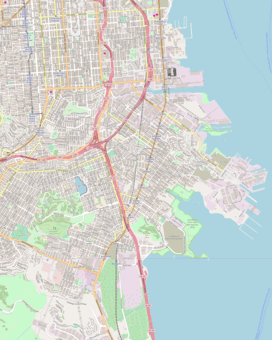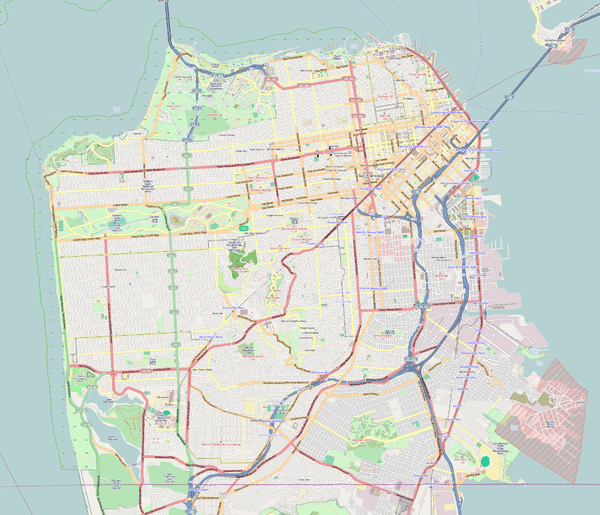Bayshore station (Caltrain)
| Commuter rail | |||||||||||||||
|
A northbound train at Bayshore station in 2012 | |||||||||||||||
| Location |
400 Tunnel Avenue San Francisco, California | ||||||||||||||
| Coordinates | 37°42′27″N 122°24′07″W / 37.70750°N 122.40194°WCoordinates: 37°42′27″N 122°24′07″W / 37.70750°N 122.40194°W | ||||||||||||||
| Owned by | Peninsula Corridor Joint Powers Board | ||||||||||||||
| Line(s) |
Caltrain | ||||||||||||||
| Platforms | 2 side platforms | ||||||||||||||
| Tracks | 4 | ||||||||||||||
| Connections |
| ||||||||||||||
| Construction | |||||||||||||||
| Parking | Available | ||||||||||||||
| Bicycle facilities | Lockers available | ||||||||||||||
| Disabled access | Yes | ||||||||||||||
| Other information | |||||||||||||||
| Fare zone | 1 | ||||||||||||||
| History | |||||||||||||||
| Opened | 1907 | ||||||||||||||
| Traffic | |||||||||||||||
| Passengers (2017) |
246 per weekday[1] | ||||||||||||||
| Services | |||||||||||||||
| |||||||||||||||
| Location | |||||||||||||||
 Bayshore Location within Bayview-Hunters Point  Bayshore Bayshore (San Francisco County)  Bayshore Bayshore (San Francisco) | |||||||||||||||
Bayshore is a Caltrain commuter rail station on the border of San Francisco, California and Brisbane, California. The parking lot and about the northern fourth of the platforms are in the Visitacion Valley District of San Francisco; the remainder is in Brisbane. The official address is in San Francisco.
Like most Caltrain stations it is not staffed with ticket sellers; passengers buy tickets from machines.
Station amenities
- Caltrain ticket vending machines
- Pedestrian walkway above tracks to cross to the opposite platform.
Platforms and tracks
| Northbound | ■ Local service | toward San Francisco (22nd Street) |
| ■ Limited-stop service | toward San Francisco (22nd Street) | |
| Express tracks | ■ Baby Bullet | No stops |
| Southbound | ■ Local service | toward Gilroy (South San Francisco) |
| ■ Limited-stop service | toward Tamien, Gilroy during peak hours (South San Francisco) |
Four tracks pass through, two in the middle and two side tracks for trains stopping at the station. During commute hours on weekdays, some trains are scheduled to wait at Bayshore on the side tracks until the Baby Bullet passes on the bypass track. A centerline fence prevents passengers from running across the four rails.
Unbuilt connection to Muni
Muni intended to establish another light rail connection to the Bayshore station at Visitacion Valley in southern San Francisco with its new Third Street light rail extension. However, during the CTX Project, the Bayshore station was moved from San Francisco down south toward San Mateo County—currently, the platform itself is in Brisbane while the main parking lot is in San Francisco. To complicate matters, this connection has also been plagued by cost and design issues. The Third Street extension opened in early 2007 without the connection. Two proposed development projects adjacent to the station, the Visitacion TOD Project [2] and the Brisbane Baylands,[3] could hasten the planning and conversion of the Bayshore Station into an Intermodal Transit Station.
The closest Muni station, Arleta Station, is about a seven-minute walk north from the Bayshore Caltrain station.[4]
The San Francisco County Transportation Authority adopted the Bayshore Intermodal Station Access Study in 2012. As of 2018, the northern end of the existing Bayshore station platform straddles the border between San Mateo and San Francisco counties. The study examined several alternatives to move the platform south by 150 to 700 feet (46 to 213 m) to lie completely within San Mateo County, and a loop extension would be built largely on San Mateo County land connecting the Sunnydale Station to a new intermodal platform west of the Peninsula Corridor rail line on land planned for redevelopment as part of the Brisbane Baylands development. The new platform would also serve a proposed bus rapid transit line along an extended Geneva Avenue.[5]
History
Bayshore was established by the Southern Pacific Railroad in 1907 along the new Bayshore Cutoff, a more direct route into San Francisco. The railroad planned to build an extensive terminal facility in Visitacion Valley that would serve as the primary maintenance and marshaling facility for the San Francisco Peninsula. Financial problems delayed completion of the project, and the 250-acre (1.0 km2) Bayshore rail yard and shops did not open until 1918. The facility operated around the clock and employed over 1,000 workers.
The Bayshore shops maintained all the locomotives on the Southern Pacific's Coast Division which stretched south to Santa Barbara. By 1952, this was 133 steam engines, but by 1954, diesel-electric locomotives had become common enough that the Bayshore steam shops were closed. The roundhouse continued to service diesel locomotives, but the decline of industry and shipping in San Francisco and along the peninsula led to the closure of the yards in the early 1980s.
References
- ↑ Caltrain. "2017 Annual Count Key Findings Report" (PDF). Retrieved 2018-01-29.
- ↑ http://www.renewvisvalley.com
- ↑ http://www.brisbanebaylands.com
- ↑ Google Maps walking directions
- ↑ Bayshore Intermodal Station Access Study (PDF) (Report). San Francisco County Transportation Authority. March 2012. Retrieved 3 July 2018.
External links

- Caltrain Bayshore station page
- Vistacion Valley TOD Project
- Brisbane Baylands Project
